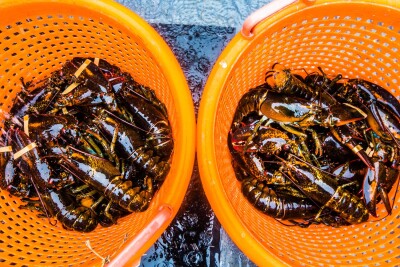The Bering Sea fleet fished on a total allowable catch (TAC) quota of 2.15 million pounds of red king crab in October. Though the regulatory season runs until Jan. 15, the 2023-2024 fishery just lasted until Nov. 18, with 31 vessels delivering nearly all the quota.
Weighing in at an average 6.6 pounds each, the crabs were a bit larger this year than the average 6.11 pounds during the 2020-2021 fishery.
Biomass estimates from National Marine Fisheries Service trawl surveys conducted last summer put the crab population above the threshold to set a quota and warranted the season this year. The fishery had been closed since the 2020-2021 season. Ex-vessel prices averaged $8 per pound.
“Overall, most vessels reported good fishing and did not have trouble catching this year's small quota,” says Ethan Nichols, area management biologist with the Alaska Department of Fish and Game in Dutch Harbor.
The Eastern and Western Bering Sea tanner crab fisheries also opened on Oct. 15 and will stay open until March 31. The TAC for Eastern Bering Sea fishery was set at 760,000 pounds. As of Dec. 5 a fleet of 15 vessels had harvested 658,918 pounds, and Nichols expected the fleet to resume fishing after the winter holidays. So far, the tanners averaged 1.71 pounds, which was slightly larger than crab caught in the 2022/2023 season, and ex-vessel prices stretched between $2.50 and $3 per pound.
Dockside prices were the same for the Western Bering Sea tanner fishery but with a larger quota and a smaller fleet. As of Dec. 20, seven vessels had landed 196,697 pounds of a 1,320,000-pound quota, about 15 percent. Nichols predicted effort would continue after the new year.
“Overall, nearly all vessels have reported slow fishing, but with catch per unit of effort (CPUE) starting to improve in the second half of November,” said Nichols.
As for the Bering Sea’s missing opilio crab, the most recent scientific theory is that more than 10 billion of them succumbed to an underwater famine. Studies monitoring long term water temperatures in the Bering Sea note that the Bering Sea has been warming gradually since 1854, but with spikes in 2010, 2018 and 2019. The warming waters sped up the metabolism in the crabs.
The National Oceanic and Atmospheric Administration study “Draft Environmental Assessment for Proposed Amendment to the Fishery Management Plan for the Bering Sea and Aleutian Islands King and Tanner Crabs” focuses on sea surface temperature increases since 1854 and reports an abrupt rise since 2010.
The study concludes that “borealization” – a term describing the shift from an arctic ecosystem to a subarctic regime – holds consequences to cold water species such as opilio crab. Two more independent studies correlate warming sea surface temperatures with opilio crab mortality rates since 2018.
At first it was thought that the crab couldn’t survive rising temperatures, but a more recent study, penned by Cody Szuwalski, a biologist at NOAA, eliminated the variable that crab couldn’t survive in warmer water temperatures, proposes that the warm water jacked the crabs’ metabolism, and suggests there just wasn’t enough food to go around. The theory is supported by other surveys and fisheries-related data showing lower body weights at age, which indicate a shortage of food.
As an added cause of their demise, the crab may have migrated in search of colder water—and the associated sources of food – only to wind up in areas supporting high concentrations of Pacific cod, a key predator. With sea surface temperatures running about 1.5 degrees Celsius above the long-term historical average, scientists and managers say it could take years of cooler temperatures to rebuild the population to numbers that would justify opening a fishery.






